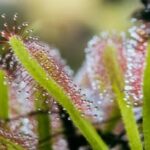As an Amazon Associate, this site earns commissions from qualifying purchases. For more details, click here.
If you look inside a pitcher plant you will see some fluid, and yes that is water. But is it safe to drink water from these plants? Or are you better off avoiding this since nepenthes plants use it to catch prey? You have probably seen animals and even some people drinking from it, but is this a good idea?
You can drink from a pitcher if it has been cleaned and its liquid content removed. The pitcher contains water as well as viscous liquids used to trap and dissolve insects. Once the pitcher is emptied and cleaned, you can put drinkable water or even food in it.
What Happens When You Drink Pitcher Plant Water?
You have probably seen orangutans drinking from pitcher plants and wondered if we can do the same. Well the answer is yes we can under the right conditions
The water in a pitcher plant is pH 7.0, which is safe for humans to drink. But the pitcher also contains digestive liquids and most likely remains from half eaten bugs,, so drinking from it is not a good idea. But if we could remove the bugs and the digestive enzymes and leave only the water, yes it is safe.
Monkey drink form the pitcher straight on, but for humans we should clean it first. Afterwards we can put water, juice or food in the pitcher. Once cleaned it can be used literally like a pitcher.
If your pitcher plant is indoors and not eating any bugs, cleaning is still recommended. After all you probably feed it. While freeze dried foods like Hatortempt Mealworms are good for pitcher plants, you wouldn’t want this stuff in your drink.
Why Pitcher Plants Have Liquids
Pitcher plants produce nectar to draw prey, and the slippery edges of the leaves cause bugs to fall into the liquid. This liquid is made up of rainwater and phytotelmata which allows the plant to eat the bug. The liquid dissolves the insect so nepenthes can absorb its nutrients.
What this means is the water in pitcher plants may contain partially digested insects. Drinking small amounts of dissolved bugs is probably harmless but most people will probably say no. This will also alter the taste of the water, making it unpleasant.
You have probably seen people fill pitcher plants with water, rice and other foods. There is nothing wrong with that as long as the pitcher has been cleaned up.
So is water from pitcher plants safe? Yes, but you should get rid of any bugs that might be mixed in with the liquid.
If there are no insects you can drink the water. There is nothing to worry about as it is like drinking rainwater. And if the plant has not eaten in a while, it will not release any digestive liquids.
Pitcher plants are not poisonous, and this is explained in detail here. If anything the water will satisfy your thirst which is good. There is no scientific proof that the digestive fluids are bad for humans. But if you have a sensitive stomach it is best to avoid those as well as half eaten insects.
What is the Liquid in Pitcher Plants?
The liquid found in nepenthes is known as phytotelmata. It refers to both the cavity made by the cupped leaves and the liquid inside it. This liquid traps insects and is used by pitcher plants for digestion.
Phytotelmata in pitcher plants is formed by its leaves and contains water and other liquids. Other plants have phytotelmata, but only pitcher pants use it to hold fluids for eating prey.
Pitcher plants like nepenthes Bloody Mary grow in nutrition poor soil, but they still require nitrogen and other elements. Since they are absent from the ground, the plant has to absorb them from insects.
Because pitcher plants are fixed to their spot, they have to find ways to draw prey. This is where the liquid substance comes in.
How Liquid Helps Pitcher Plants Catch Prey
Nepenthes generates nectar and other liquids to draw the attention of prey. This is also responsible for making the pitcher surface slick.
When an insect lands on the edge of a nepenthes to eat the nectar, the trap is set. The wet surface causes the bug to fall into the cavity. There the liquid makes it difficult if not impossible to escape.
After some time the liquid starts dissolving the insect. The plant might also release digestive enzymes to dissolve the prey faster.
Once the tissues are liquefied the pitcher plant will soak it in though its leaves. Strictly speaking this is more like drinking a dissolved bug than eating, but you get the idea. This is also how pitcher plants eat Jessi Mae Freeze Dried Mealworms and other nutritious foods.
But what happens if it rains? The water will wash away most of the liquid as well as any insect remains. Think of the rain as helping clean the cavity so it will be ready to eat more food.
There are many kinds of pitcher plants but they basically have the same kind of liquid. The trapping mechanism is also similar across the many pitcher variants.
What Happens If You Touch Pitcher Plant Liquid?
So we have established that the water is safe to drink. Does it follow the liquid is safe to touch as well? While the liquid contains other substances besides water, it is not harmful.
It is safe to touch the liquid produced by pitcher plants because it does not contain any dangerous substances that could irritate or burn your skin. The liquid can be washed off and will not leave any traces.
The liquid has s viscous consistency because it contains elements needed to dissolve insects. Pitcher plant leaves also produce a sticky substance to trap insects and other small animals drawn to its nectar.
If your nepenthes has not eaten any bugs, the leaves should hold mostly rainwater. If it has consumed prey, there will be digestive enzymes and some leftover insect remains.
Pitcher plants produce these liquids to trap prey. The closed leaves are filled with water and bacteria that enables the plant to eat bugs.
If you have the stomach for it you can drink the liquid. You might get an upset stomach for a while, but some people do not even experience that. To be safe of course you should clean the pitcher first.
Touching the liquid is fine because those substances do not have any irritants. It probably feels unpleasant but nothing that will harm your skin.
While this liquid is harmless to humans, it is dangerous for small insects. The viscous nature of these liquids are enough to liquefy insect tissues, allowing the plant to eat it.
Once the prey has been dissolved the plant converts it into nitrogen, phosphorus and other vital nutrients. However its ability to melt tissues is only for small prey. You can dip your finger in the liquid and nothing will happen.
Pitcher Plant Growing Tips
If you want to grow pitcher plants at home, here are some tips to help you get started. These are applicable to the most popular variants.
Like all carnivorous plants, nepenthes prefer poor soil. The standard media used is 1:1 peat and perlite or 1:1 peat moss and silica sand. Some nepenthes can still grow with a small amount of nutrition in the soil. But it is best not to risk it. If your pitcher plant came with a suggested soil mixture, use that.
All pitcher plants thrive in moist soil. Do not completely soak the ground and do not fill the pitchers with water. Just keep the soil damp and the plant will be fine.
Optionally, you can mist nepenthes with a small amount of fertilizer. Add 1/4 teaspoon per gallon. You can do this during summer and spring, but really it is not necessary. With or without this fertilizer the plant should grow if it gets enough light, water and food.
As for food, 1-4 insects a month is fine. Many pitcher plants eat only twice a month and they continue to grow. Do not stuff the cavity with insects as this will overwhelm the plant.
Most nepenthes will grow fine indoors or outdoors (as long as it is not too cold). Sarracenia prefers outdoors and require the winter freeze for its dormancy.
And speaking of light pitcher plantsshould get 6-8 hours a day, preferably natural, direct sunlight. Partial light is also good provided it is several hours long. You may also use artificial lighting indoors.
Conclusion
So yes, it is safe to drink the water from nepenthes, and you can even use it as a jug. The most important thing however is to make sure that it is cleaned first. Once you do that you can use this plant to store your drinks with confidence.

My fascination with carnivorous plants began many, many years ago with Venus Fly Traps. Now I am more than happy to impart what I know with other enthusiasts and those who are curious about meat eating plants.



